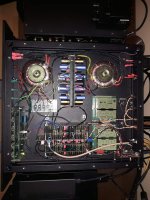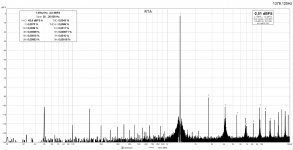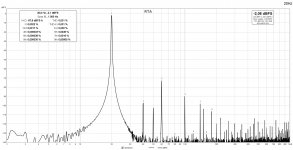Vin, thank you for the response!
Hi Werner,
Yes, except the turns ratio, it should be higher. The higher the turns ratio, the less impedance is seen by DAC itself (better for its current output). Higher turns ratio means higher output impedance. Higher output impedance means additional requirements to the next stage load as the impedance can be too high for "lossless" delivery.
That is why it is better to set a jfet/tube buffer right after transformers as close as it possible to them to avoid unwanted capacitive load. And when you get the output impedance of couple tens Ohms - deliver it everywhere you want without issues.
The latest trafos (your's too) are with 1:8 turns ratio. Ian's DM 38Q2M has twice higher output current than 1541A, so I use 1:14 version of trafos now as I am on full 20W output power on my speakers with 0.38Vrms after 1541A DAC.
If someone needs 2V from 1541A those can use amplification on tubes (I do not believe in qualitied voltage amplification on transistors) after trafos. Tubes is quite another approach with its own 'circuit-etiket and ecosystem" - just another story, too individual in ost cases and I am really can not comment the result. Another approach I see is better IMO. To use two transformers with the current follower on jfets between and after (if needed) transformers:
trafo-jfet-trafo-jfet.
Hi Werner,
Yes, except the turns ratio, it should be higher. The higher the turns ratio, the less impedance is seen by DAC itself (better for its current output). Higher turns ratio means higher output impedance. Higher output impedance means additional requirements to the next stage load as the impedance can be too high for "lossless" delivery.
That is why it is better to set a jfet/tube buffer right after transformers as close as it possible to them to avoid unwanted capacitive load. And when you get the output impedance of couple tens Ohms - deliver it everywhere you want without issues.
The latest trafos (your's too) are with 1:8 turns ratio. Ian's DM 38Q2M has twice higher output current than 1541A, so I use 1:14 version of trafos now as I am on full 20W output power on my speakers with 0.38Vrms after 1541A DAC.
If someone needs 2V from 1541A those can use amplification on tubes (I do not believe in qualitied voltage amplification on transistors) after trafos. Tubes is quite another approach with its own 'circuit-etiket and ecosystem" - just another story, too individual in ost cases and I am really can not comment the result. Another approach I see is better IMO. To use two transformers with the current follower on jfets between and after (if needed) transformers:
trafo-jfet-trafo-jfet.
Hi Ivan, I am another DDDAC user who has been playing around with output devices - capacitors and transformers both with this DAC. My DDDAC also has 4 boards (meaning 8 PCM1794 chips in total). With capacitor coupled output (Single Ended), I get 1.4Vrms. I also own a pair of Cinemags CMLI 15/15B transformers, which provides me with a balanced output and takes the Vrms to 2.7Vrms or thereabouts (basically double than capacitors). I find the Cinemags to be better than the caps in some ways and worse in some. I dont enjoy the bass response of the cinemags with this dac as much as I do with some capacitors.
Now, my requirement is a bit specific. My preamp is a DHT tube 4P1L amp with input impedance of 470Kohm. It does not have any dc blocking capacitors on the input. This preamp is driven well even with the 2.7vrms of the dddac with the cinemags. So basically, I need a higher Vrms and better bass response than what I get currently. I feel if in place of a 1:1 transformer, I get a 1:2, and I get say around 4+ Vrms, the preamp will be really happy and I will have enough headroom. Right now the dac sounds a bit anaemic to be honest. I do get the following readings when I measure the output DC voltages on the DAC. There is a DC imbalance between the channels, but all within spec as confirmed with the DAC designer.
Considering that you have already taken a look at this dac, and the fact that I have 4 boards and the fact that I need around 4+ Vrms output and the fact that I might have some VDC imbalance on the output, can you suggest if I can try your transformers in place of the Cinemags and it can do the job for me? The special Sowter transformers for this dac which gives out a 1:2 winding ratio and a 4+ Vrms are out of my budget. The Sowter's primary resistance is 2 ohms. I am pasting one detail which the DAC designer gave out on his thread regarding these special sowter transformers:
"The special DDDAC Sowter was designed by Brian Sowter specially with the DDDAC topology in mind. Being able to consume some DC offset at the input . This resulted in a very low number of windings and low Inductance. Meaning you need a very low output impedance (hence the 4 or more decks).
Now the side effect of these very low windings was that the transformer has a large bandwidth and less stray capacitance"
Now standard of the shelf transformers must be able to be used by a wide variety of sources, hence the primary winding has a high induction. The con is less bandwidth and other losses and the less fit for DC offset
so for most standard transformers the output impedance of one deck (266 Ohm) should be sufficient for most
For the special case of the DDDAC Sowter this was designed by Brian Sowter to be able to absorb some DC offset (which the DAC has) like less windings is "better" - also MU metal case etc , but the less winding´s was key. Hence the induction is low. leading to a good HF response as well, but now with the con side that the you need a low output impedance. the induction is like 0,7H (where the standard ones are more like 10H or more)
with one deck this will lead to a Fc of ~ 60Hz
so with 4 decks this will be 15 Hz, hence the recommendation to use 4 decks with the special DDDAC Sowter
I am not very technical so whatever you might ask me, either Nixie can help answer or I will have to fetch the answers from the DDDAC thread.
Now, my requirement is a bit specific. My preamp is a DHT tube 4P1L amp with input impedance of 470Kohm. It does not have any dc blocking capacitors on the input. This preamp is driven well even with the 2.7vrms of the dddac with the cinemags. So basically, I need a higher Vrms and better bass response than what I get currently. I feel if in place of a 1:1 transformer, I get a 1:2, and I get say around 4+ Vrms, the preamp will be really happy and I will have enough headroom. Right now the dac sounds a bit anaemic to be honest. I do get the following readings when I measure the output DC voltages on the DAC. There is a DC imbalance between the channels, but all within spec as confirmed with the DAC designer.
Considering that you have already taken a look at this dac, and the fact that I have 4 boards and the fact that I need around 4+ Vrms output and the fact that I might have some VDC imbalance on the output, can you suggest if I can try your transformers in place of the Cinemags and it can do the job for me? The special Sowter transformers for this dac which gives out a 1:2 winding ratio and a 4+ Vrms are out of my budget. The Sowter's primary resistance is 2 ohms. I am pasting one detail which the DAC designer gave out on his thread regarding these special sowter transformers:
"The special DDDAC Sowter was designed by Brian Sowter specially with the DDDAC topology in mind. Being able to consume some DC offset at the input . This resulted in a very low number of windings and low Inductance. Meaning you need a very low output impedance (hence the 4 or more decks).
Now the side effect of these very low windings was that the transformer has a large bandwidth and less stray capacitance"
Now standard of the shelf transformers must be able to be used by a wide variety of sources, hence the primary winding has a high induction. The con is less bandwidth and other losses and the less fit for DC offset
so for most standard transformers the output impedance of one deck (266 Ohm) should be sufficient for most
For the special case of the DDDAC Sowter this was designed by Brian Sowter to be able to absorb some DC offset (which the DAC has) like less windings is "better" - also MU metal case etc , but the less winding´s was key. Hence the induction is low. leading to a good HF response as well, but now with the con side that the you need a low output impedance. the induction is like 0,7H (where the standard ones are more like 10H or more)
with one deck this will lead to a Fc of ~ 60Hz
so with 4 decks this will be 15 Hz, hence the recommendation to use 4 decks with the special DDDAC Sowter
I am not very technical so whatever you might ask me, either Nixie can help answer or I will have to fetch the answers from the DDDAC thread.
Thank you very much kartick for this info.
AFAIK the Sowter uses an air gap to avoid core oversaturation (to be honest I do not believe that it is needed as my cores works OK with a some DC-offset, 1541 for example). Anyway I can say - it will be a disaster for SQ if I will use a gapped core for DACs. It is like to split a solid diamond to few crystals
I think yes.
AFAIK the Sowter uses an air gap to avoid core oversaturation (to be honest I do not believe that it is needed as my cores works OK with a some DC-offset, 1541 for example). Anyway I can say - it will be a disaster for SQ if I will use a gapped core for DACs. It is like to split a solid diamond to few crystals

Considering that you have already taken a look at this dac, and the fact that I have 4 boards and the fact that I need around 4+ Vrms output and the fact that I might have some VDC imbalance on the output, can you suggest if I can try your transformers in place of the Cinemags and it can do the job for me?
I think yes.
Thank you very much kartick for this info.
AFAIK the Sowter uses an air gap to avoid core oversaturation (to be honest I do not believe that it is needed as my cores works OK with a some DC-offset, 1541 for example). Anyway I can say - it will be a disaster for SQ if I will use a gapped core for DACs. It is like to split a solid diamond to few crystals
I think yes.
Thanks Ivan. I will connect with you via PM as well. Also, will be happy if other DDDAC users can chime in.
@kartick, I've calmed down for now with ISKRA transformers 1:1 at the output. They are wound on a torus, inductance 1.4-1.5H, ohmic resistance 20ohm. The bass is very good with 4 decks, they sound a lot better than Cinemag. ISKRA (used) I paid locally only 30eur/pair. I will follow developments with your DDDAC regarding output transformers.
My estimate is that the ideal transformer for a DDDAC with 4 decks should have a primary of about 3-4H, and with 2 decks around 6-8H due to the frequency range at low frequencies. Sowter is at primary 3.4H and not 0.7H as you wrote. With just a couple of mV DC offset, there is no problem with any transformer, aig gap is not required.
My estimate is that the ideal transformer for a DDDAC with 4 decks should have a primary of about 3-4H, and with 2 decks around 6-8H due to the frequency range at low frequencies. Sowter is at primary 3.4H and not 0.7H as you wrote. With just a couple of mV DC offset, there is no problem with any transformer, aig gap is not required.
Attachments
Last edited:
@kartick, I've calmed down for now with ISKRA transformers 1:1 at the output. They are wound on a torus, inductance 1.4-1.5H, ohmic resistance 20ohm. The bass is very good with 4 decks, they sound a lot better than Cinemag. ISKRA (used) I paid locally only 30eur/pair. I will follow developments with your DDDAC regarding output transformers.
My estimate is that the ideal transformer for a DDDAC with 4 decks should have a primary of about 3-4H, and with 2 decks around 6-8H due to the frequency range at low frequencies. Sowter is at primary 3.4H and not 0.7H as you wrote. With just a couple of mV DC offset, there is no problem with any transformer, aig gap is not required.
Thanks Nixie. I shall be in touch with you to compare note on our DAC builds.
I got the transformer from Ivan for a few weeks now.
I am using the ES9038Pro board from Quanhao. I have previously tried Lundahl LL1684 as suggested by Quanhao. With LL1684, the DAC is in voltage mode.
I am using 1K as the secondary resistor.
I must say Ivan TX is 2 step in performance above compare to LL1684 as Ivan's tx is forcing the DAC in current mode. Also probably Ivan's TX is built to match the DAC characteristics whereas LL1684 is an excellent but general transformer.
Every instrument just sound as what it should be. 'Stage' is just brilliant. You can hear every layer.
My next project is to build a Twistpearl ES9038Pro module using all separate batteries to the crystal, separate batteries for left and right analog supply to the dac...etc using Ivan's TX.
Alan
I am using the ES9038Pro board from Quanhao. I have previously tried Lundahl LL1684 as suggested by Quanhao. With LL1684, the DAC is in voltage mode.
I am using 1K as the secondary resistor.
I must say Ivan TX is 2 step in performance above compare to LL1684 as Ivan's tx is forcing the DAC in current mode. Also probably Ivan's TX is built to match the DAC characteristics whereas LL1684 is an excellent but general transformer.
Every instrument just sound as what it should be. 'Stage' is just brilliant. You can hear every layer.
My next project is to build a Twistpearl ES9038Pro module using all separate batteries to the crystal, separate batteries for left and right analog supply to the dac...etc using Ivan's TX.
Alan
Thanks for the feedbak, Alan!
Meanwhile I have done a homework around the TDA1541A. The truth is pretty well known from other 1541 users, that the i/v impedance seen by DAC should be not more than 20 Ohms to get the undistorted signal within all the range. Here are some measurements.
Configuration is: TDA1541A (SE) loaded on to 14 Ohm handmade resistor -> 1:15 trafos-> 4.7k||k170/j74 buffer (current follower) -> 1:8.3 trafos->4.7k||k170/j74 buffer->350Ohm||RCA.
i/v seen by DAC is ~8.4 Ohm. 0.12Vrms after first transformer.
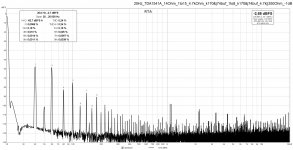
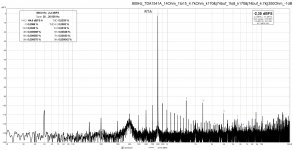

Output (@1kHz): 1Vrms (impedance ~15 Ohm)
LF: -2.5dB@5Hz
HF depends on Player, better to look at square signals:
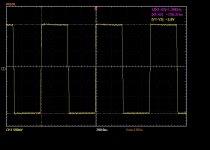
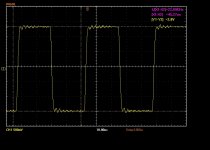
Meanwhile I have done a homework around the TDA1541A. The truth is pretty well known from other 1541 users, that the i/v impedance seen by DAC should be not more than 20 Ohms to get the undistorted signal within all the range. Here are some measurements.
Configuration is: TDA1541A (SE) loaded on to 14 Ohm handmade resistor -> 1:15 trafos-> 4.7k||k170/j74 buffer (current follower) -> 1:8.3 trafos->4.7k||k170/j74 buffer->350Ohm||RCA.
i/v seen by DAC is ~8.4 Ohm. 0.12Vrms after first transformer.



Output (@1kHz): 1Vrms (impedance ~15 Ohm)
LF: -2.5dB@5Hz
HF depends on Player, better to look at square signals:


And here is a demo track of the whole system (DAC-AMP-Speakers) recorded on Pixel3 phone (later I will try to record not on to the phone, in order to transfer low frequencies as well) in my room.
it is mp3@160kbps (can't upload higher br)
View attachment sample_160.mp4
it is mp3@160kbps (can't upload higher br)
View attachment sample_160.mp4
I am interested for AD 1862 dac.which transformer would you advice then?
Eventually I would maybe try a pcm i out dac such as pcm1704 can I use the same transformer.
Eventually I would maybe try a pcm i out dac such as pcm1704 can I use the same transformer.
I would recommend 1:22 transformer as both 1862 and 1704 are not very strong in terms of output current. What is the sensitivity of the next stage and its input impedance?
Sensitivity is 'normal' now i use input from surround receiver, but a dedicated pre amplifier is planned such as Pass B1 korg or so
An 1:4 transformer with additional tube amplifier stage after that is not an option ?
An 1:4 transformer with additional tube amplifier stage after that is not an option ?
The output current of 1862 is 0.7mArms. The i/v seen by DAC in terms of SQ is better to keep under 20 Ohm. So, calculating: 0.0007*20*4(turns ratio)=56mVrms of the output signal. What to do with such a low signal next is a task for next stage calculations...
Last edited:
I reckon now have 1,8 volt output, that’s rather good. The pass b1 korg has input impedance of 50kohm
If you talking about this circuit B1 with Korg Triode
then according to mentioning about 16dB gain of circuit, you will get 0.35V only from 56mV.
You can use two trafos in series or to use more gained active circuit or combining them. Another way is to increase the i/v seen by DAC, but even 20 Ohms is far from DACs 20 bit resolution.
then according to mentioning about 16dB gain of circuit, you will get 0.35V only from 56mV.
You can use two trafos in series or to use more gained active circuit or combining them. Another way is to increase the i/v seen by DAC, but even 20 Ohms is far from DACs 20 bit resolution.
here is a ribbon-mic version of previous demo track:
View attachment sample_160_mic.mp4
And another one for LF response (no eqs/subs, linear stereo system on single OTL):
View attachment LF_sample_160.mp4
View attachment sample_160_mic.mp4
And another one for LF response (no eqs/subs, linear stereo system on single OTL):
View attachment LF_sample_160.mp4
here is a ribbon-mic version of previous demo track:
View attachment 956841
And another one for LF response (no eqs/subs, linear stereo system on single OTL):
View attachment 956843
Hi Ivan,
What was the over sampling rate of these recordings?
Can you tell us more about your system?
Do you have room treatment?
- Home
- Vendor's Bazaar
- Output transformers for DACs
 Some images from the first post, which are no longer relevant have been deleted.
Some images from the first post, which are no longer relevant have been deleted.